6 Copywriting Tips That’ll Keep Readers Eyes Glued to Your Screen
55% of all page views only get a few seconds of attention.
What does that mean for you?
Your hook had better be good and quick. Otherwise, your blog posts are not going to get read.
Start off with bland and unengaging content, and you can kiss valuable blog traffic goodbye.
Not enough of an incentive for you?
Visitors who read more of the post are more likely to return.
Users who read a blog post for three minutes were 2x more likely to return to that site than those who only read for one minute.
That’s all you get.
People skim. They don’t read as much as they used to.
And it makes sense when you consider what you’re up against. There’s too much daily content out there to get through it all.
It takes too long to digest everything.
But if you want your readers to convert, you have to keep their attention.
Enter long-form content. It works because it converts.
But you can’t just throw up 3,000 random words and expect it to engage your website visitors. You need to make sure your writing is good. Really good.
Get your readers to continue to scroll down the page and come back for more by amping up your copywriting skills.
Here are six copywriting tips to step up your content game and keep readers on your page.
1. Proven methods net proven results
Why do people use clichés so much?
Because many times they turn out to be true!
Like, “There’s no need to reinvent the wheel.”
That cliché is definitely true when it comes to copywriting. The stuff that worked decades ago can still work today if you do it right.
I’m here to tell you that the notion that people are “either born with the copywriting gene or not” is a total myth.
In fact, let me tell you an even greater secret.
If copywriting doesn’t come naturally for you, there are plenty of tricks at your disposal to make your content better.
Like copywriting formulas, for instance.
You can use these to take all the guesswork out of writing good content. These formulas should be your go-to starting point every time.
One of my favorites is the PAPA formula.
Problem, advantages (of solving the problem), proof (that you can solve it), and action.
Here’s how it looks in action:
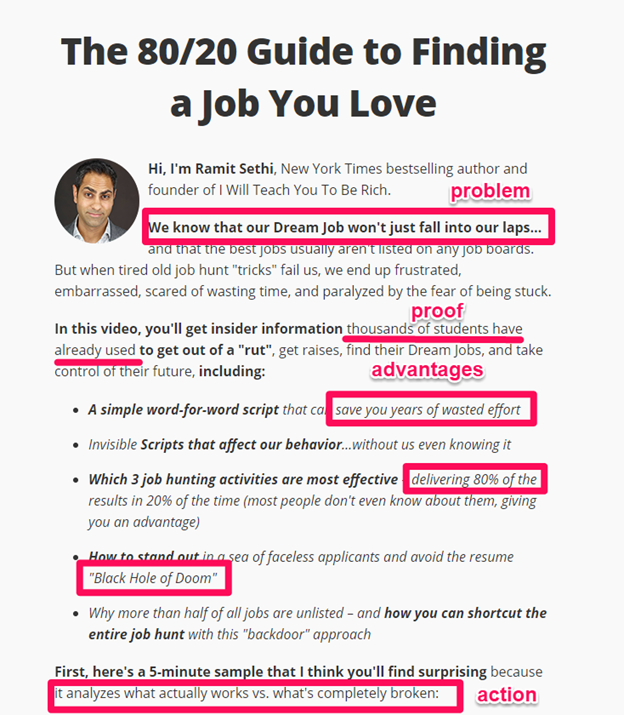
First, you present the problem. This is the need or pain point that your customers are facing.
In this example, that’s the “struggle to find your dream job.”
Then, you move in with the advantages or reasons why this person needs to fix the problem.
In this case, that looks like saving “years of wasted effort” or avoiding the “resume black hole.”
Next, you provide proof of your product solving the problem:
“Thousands of students have already used it to get ___ results.”
Then you close and seal the deal with an action-oriented task, like watching a video, signing up for a lead magnet, or clicking a CTA.
My second favorite copywriting method is the 4 Ps.
Problem, promise, proof, and proposal.
Here’s an example from my site. On my consulting page, I start with problem and promise:
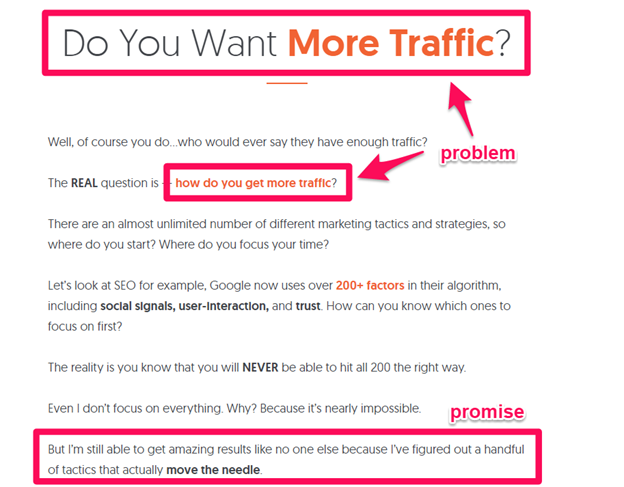
I put my audience’s problem, the lack of traffic, front-and-center.
Then, I make the promise to help find them the traffic they need.
As readers continue to scroll, I provide the proof, through positive business reviews, of delivering on the promise.
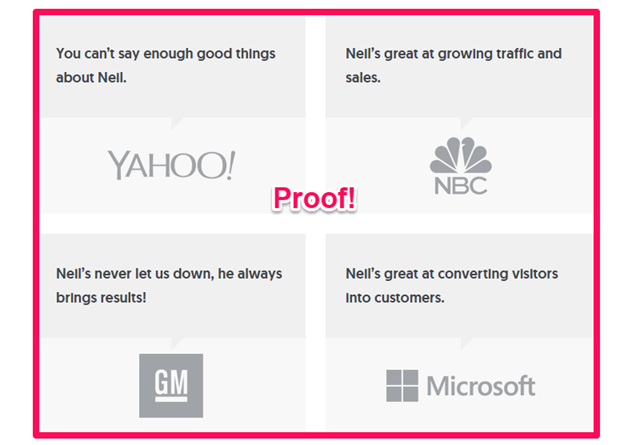
These reviews from top corporations show that you can trust my work and methods.
If it worked for these big brands, it can work for you, too.
Building this trust and providing this proof further cements the fact that I can help with the problem they are facing.
When I have them hooked and convinced, I offer a proposal to help them:

Copywriting formulas are simple and effective.
You don’t need the copywriting gene or countless hours of studying to figure out “how to write better.”
You just need to stick to the basics and use proven methods.
Instead of starting from scratch, start with a copywriting formula and build out from there.
2. Use powerful language
Have you ever started to read a blog post casually, and then 15 minutes later found yourself knee-deep in the content, unable to stop reading?Have you come across a blog post in which the writer plays perfectly on your emotions and taps into your deepest desires?
Not only do these types of posts keep you engaged and reading, but they are also hard to forget.
Creating this type of content isn’t easy. But it can be done.
And it has to be done when you’re going up against the millions of blog posts published every day.
Thankfully for us busy marketers, there’s a quick solution:
Power words.
Former British Prime Minister Winston Churchill was the master of power words. Here’s an example from a speech he made before the House of Commons in 1940.
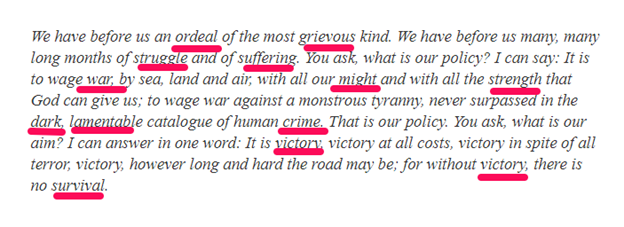
He filled the speech with inspiring words. The words drove emotion, provoking excitement and action.
These aren’t just your everyday, run-of-the-mill words. They are power words because they make you feel something.
Not writing a speech to rally your countrymen? You can still use power words for your own benefit, like on your product site:
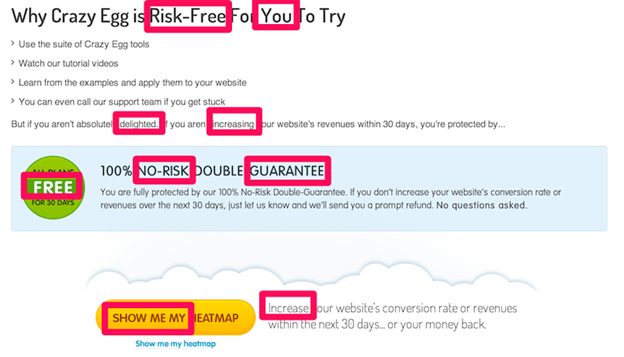
These triggering words spark emotions and get people to sit up and take notice.
Words not only have the power of persuasion and inspiration, but they can drive conversions, too.
Thankfully, Smart Blogger’s Power Words article contains 317 words that you can use immediately.
Start using power words now to increase the length of time people stay on your site and how often they come back to check out your new content.
3. Say more with less
Long-form content converts. But long-form doesn’t mean never-ending content.Being concise within the content is key when writing long-form pieces.
We’ve already established that people don’t have long attention spans. And they certainly don’t want to sift through your blog post to find the information they need.
Adding filler copy or unactionable writing to make it more “long-form” will only annoy your readers.
People will see right through your fluff and filler.
But don’t take my word for it. Moz adopted the principle of being concise with their newsletter and saw much higher click-through rates:
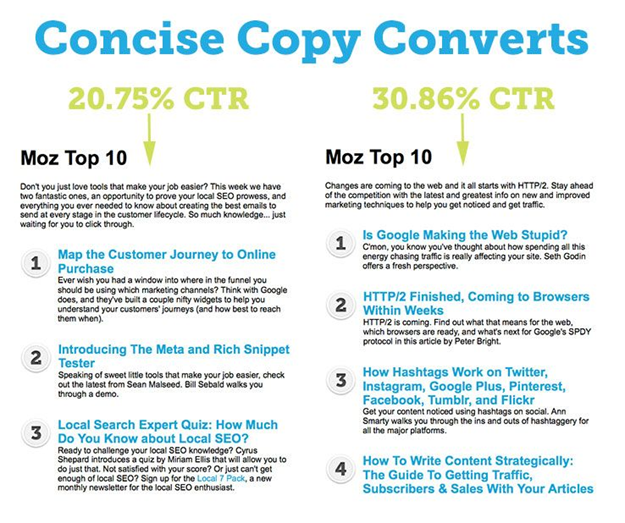
That’s not too surprising, right?
But just because long-form content converts doesn’t mean you should write for the sake of producing a certain amount of words on the page.
Each post should pack meaning in as few sentences as possible.
Check out how Apple does it on its product pages:

It uses a quick, snappy headline that basically condenses multiple sentences of information into just three words.
And with just these three words, readers now know two different product benefits.
First, it’s lightweight.Second, it’s technically superior to the competition.
Then there’s a short paragraph that delivers the features and benefits. The rest of the ‘sales pitch’ is saved for the video.
In other words, sequencing plays a role.
The page gives you the most important information up front. And it keeps it as concise as possible.
Then you’re given the ability to dive deeper if you’re still onboard.
Here’s another good example from Evernote:

Two words for the title and just two short sentences for the benefits.
What am I trying to tell you? Get to the point ASAP!
I’ve picked up a few tips and tricks along the way in my own journey to perfect my copywriting.
For me, I find it helpful to write out a short, one-sentence description of the blog post to be written or the product to be sold.
This is essentially crafting the perfect headline that summarizes everything that’s going to be covered in as few words as possible.
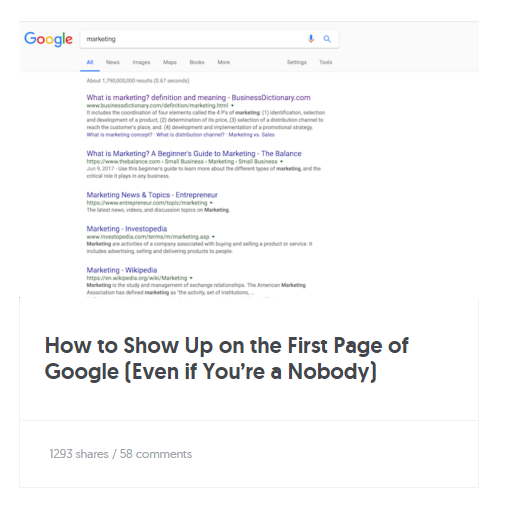
You can also try thinking about the key takeaway from your post.
What is the problem you’re solving? What exactly will a user accomplish by reading your post or buying your product?
Slack gets it in this example here:

Brainstorm the most compelling sentences you can think of that encapsulate the meaning of the entire piece.
4. Eliminate powerless words
Editing isn’t always a walk in the park, even if you’ve been writing for years.
It can be hard to weed out those subtle problems that diminish your copywriting.
For every power word you pat yourself on the back for, there’s a powerless word waiting for you one sentence down.
These words take the life out of your post and cause visitors to question why they started reading your blog in the first place.
Not only that, but they dilute the real meaning of your post.
They take up space without providing any real value. They’re squatters in your otherwise pristine piece.
Here are two basic examples:
Advanced planning. Or planning in advance.
They look seemingly harmless but don’t be fooled.
They are both redundant. Planning signifies the act of doing something before the event.
Even Google acknowledges it:
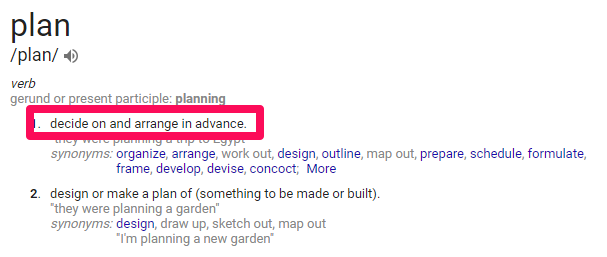
There’s no point in using the word “advance” because the meaning of the word “planning” already signifies that.
Just like their treasure-trove of words to use, Smart Blogger also put together a list of weak writing words to eliminate immediately.
Thankfully, there are also tons of tools that help clean up the jargon that sneaks into our writing.
One of my favorite ways to eliminate powerless words is using Unbounce’s Dejargonator:
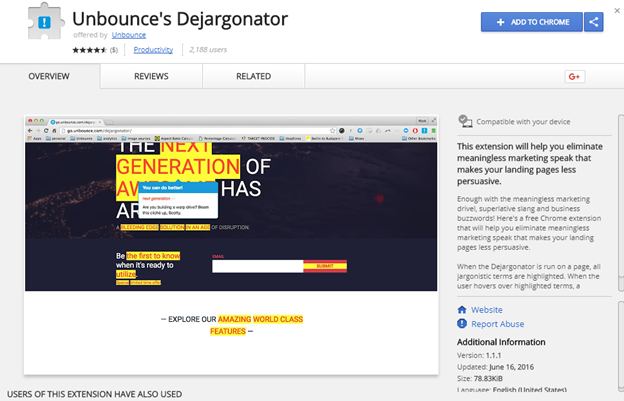
You can’t get much more jargony than a tool that’s called the “Dejargonator.”
It does exactly what it says it does. It will help you remove meaningless words that make your content less compelling and persuasive.
You see these all the time on business websites. For example, “synergy,” “world class,” or “next generation.”
They say a lot without saying anything at all.
Simply fire up one of your blog posts and get instant suggestions on how you can improve it.
Let’s do my post on ecommerce SEO to show you how it works:
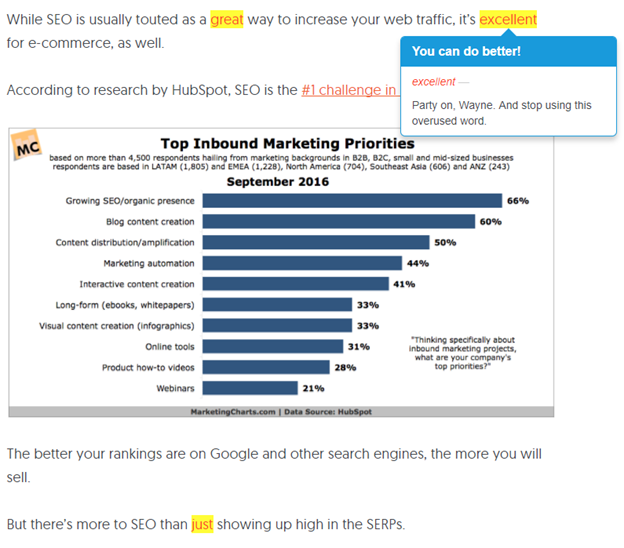
The tool will highlight unnecessary words that take the punch out of your blog post.
The ones you see most often on blog posts include words like “great,” “excellent,” or “best.”
I’m guilty of all of these, to be honest. One of my favorites is “just.”
Like in this sentence:

Read it through without the “just.” Same meaning, right? Right.
The Dejargonator can also help cut down on your editing time. It will help with the frustration of getting rid of unneeded words.

5. Use the right tools to perfect your writing
Marketers have countless tools, applications, and software at their disposal.
Well, guess what? Copywriters do, too.
First, they have to live by one simple rule: Don’t ever post the first draft.
And that doesn’t just mean giving it a once-over for a little proofreading.
Honestly, you can’t even rely on spell check.
For example, look at what Google Docs recently flagged when I was writing a post:

Um, what? That’s the correct spelling.
Another problem with spell check is that it’s only looking for spelling errors.
That means that you might use the wrong word. Or maybe you use the wrong tense.
It won’t get flagged if you’ve spelled it correctly.
No matter how good of a writer you are, mistakes happen.
Common issues include contextual mishaps, passive voice, adverbs, and readability.
You can start with a few tools to catch the big problems.
For example, the free Hemingway App will help you simplify the language.
It goes beyond the initial spell check and gives it that nice Papa Hemingway sheen:
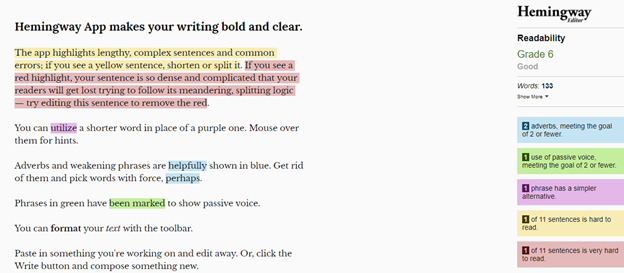
Simply copy and paste your blog post or product-page copy into the application and get detailed results on how to improve everything from sentence structure to fixing passive voice.
Here’s how I use it for my blog posts:
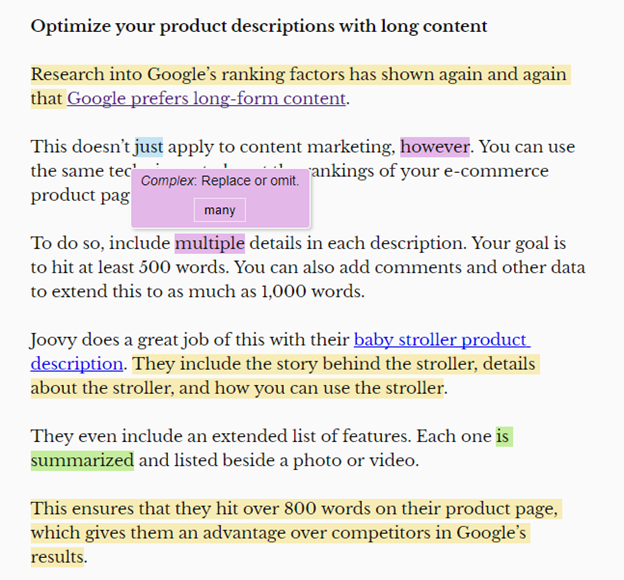
I simply paste the final text into the application and fix all the errors it finds.
It helps me fix complicated sentences to reduce friction and provides simpler alternatives to mindless filler.
The Hemingway App isn’t perfect. There will still be little issues that pop up.
So you’ll need to do a thorough, human read-through afterward.
But it can help save you some time and hassle as the first line of defense.
6. Develop a unique style and tone
Prince was a talented singer with an impressive collection of music.
But that’s not what made Prince famous all around the world.
Prince was Prince because of his style and character.
The same goes for writing. Write without a unique style or tone, and you’re just putting out a couple of thousand boring words.
Look:
There are thousands of blog posts on this website.
I love marketing! But that doesn’t mean everyone else does.
Many of the posts are technical and dry. Style helps make them readable so people stick around longer.
If you don’t have fun writing it, imagine how your visitors feel trying to read it!
Remember your 8:30 a.m. Western Civilization class Freshman year? It’s like that.
“I can’t keep my eyes open… zzzzz.”
But when you come across a unique tone and a specific style, it sticks.
You want to keep reading.
MailChimp excels at this. They even have a tone and style guide for their writers:
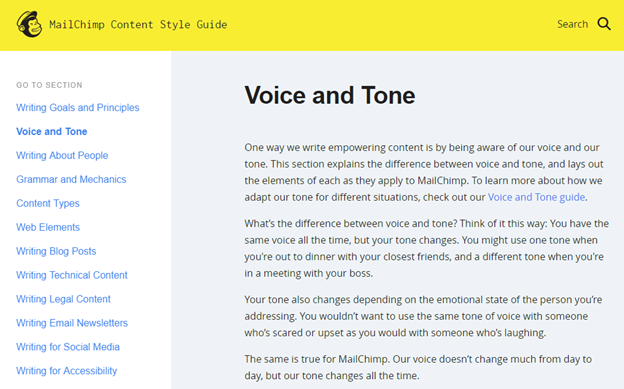
And it makes perfect sense because they’ve spent years perfecting their copywriting skills and crafting a special voice:

Or how about this headline on their homepage?

They’ve mastered the art of casual and exciting copy that resonates with their users.
Instead of tired marketing-speak, they use language that any customer would be likely to use in a normal conversation with friends or co-workers.
The goal here is to craft a unique niche within the standard copy you see in your industry.
If it’s boring, shake it up. If it’s too wild, bring it back to reality.
Conclusion
Most of your pages will only get a few seconds of reader attention.
You’re working with almost no time at all to convince people to stick around and actually care about what you have to say.
So get to the point quickly.
But make sure that people actually want to know more about the topics you’re writing about.
If you don’t, you’re risking tons of traffic and valuable visitors who might be willing to stick around to convert.
Remember: The longer people read your content, the more likely they are to return and convert.
Good copywriting takes time to get right.
But it’s not an impossible feat.
Start with the basics to keep readers glued to your content.
Tap into those proven copywriting formulas that drive real results.
Use powerful language that stirs emotion even for the most boring subjects.
And eliminate those powerless, life-sucking words from your content that do the opposite.
Make sure to use editing tools to perfect your content and pay close attention to creating and crafting your unique style and tone.
Trust me, it will be worth it.
Copywriting keeps people around long enough to eventually convert.
If you’re not already a master at it, no problem. Use these six tips to fake it till you make it.
What copywriting tips have you used to increase reader retention?
The post 6 Copywriting Tips That’ll Keep Readers Eyes Glued to Your Screen appeared first on Neil Patel.




Comments
Post a Comment